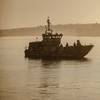Nimitz-class aircraft carrier USS John C. Stennis (CVN 74) successfully tested and operated a state-of-the-art, touch screen digital helm and lee helm during a series of sea trials that began Dec. 12.
The installation of this latest navigation technology is part of an extensive, shipwide systems upgrade and ship restoration project conducted during a Docking Planned Incremental Availability (DPIA) at Puget Sound Naval Shipyard, 10 years after the ship was commissioned in December 1995.
The ship has been in the shipyard for almost a year, undergoing the massive renovation project making the ship, as officials say, the most advanced carrier in the fleet.
The new Steer Control Console (SCC) integrates all of the mechanical features of the older helm/lee helm onto a set of graphic user interface computer consoles. The system is already in use on other aircraft carriers in the U.S. fleet and has proven to be a leap in technology and capabilities.
“The entire helm assembly occupies about one-third less space on the bridge than the older helm/lee helm,” said Lt. John Johnson, ship’s assistant navigator.
Johnson explained that the digital-graphic interface is a significant advantage over the previous analog helm/lee helm system.
“Watch standers have a tremendous amount of information at a glance on the console display. It is similar to what many have worked with on their home computers,” he said.
The console also has a simulation program that will allow watch standers to simulate special evolutions, such as pulling in or out of port, without ever having to leave the pier - a definite benefit for training exercises and preparing the crew to go to sea before actually having to do so, Johnson added.
“The new helm provides watch standers with a host of advanced casualty-control features,” said Johnson. “Through the touch screen console, watch standers are able to start and stop steering units. Additionally, they may transfer control to aft steering or over to hand-electric steering, and if a problem develops with the helm console, the helmsman may transfer control to the lee helm and steer the ship purely thorough touch-screen manipulation - much like the scroll wheel common on many popular MP3 players.”
Seaman Caitlin Gunn from Stennis’ Deck Department is one of only a few digital-helm qualified instructors aboard Stennis. Earlier this year, she spent one month aboard the San Diego-based aircraft carrier USS Ronald Reagan (CVN 76) learning to operate the system.
“The helm’s console is completely digital. It displays many different readings, including the actual position of rudder,” said the 20-year-old Hampden, Maine, native. “I help the Sailors learn under instruction what to do and say, but once the order is entered into the system, the helm takes care of the rest,” she said.
Instructional Systems Engineer Matt Andresen of Sperry Marine Systems said the new digital helm is designed to work in tandem with the new paperless-chart navigation Voyage Management System (VMS), which by direction from the Navigator of the Navy, all Navy ships should be using to navigate by 2007.
According to Anderson, the paperless-chart navigation system is designed to link directly with the digital helm to become an Integrated Bridge System (IBS).
“IBS will allow ships to navigate using various satellite technologies, including Differential Global Positioning Satellites (GPS),” Anderson said.
Additionally he explained that IBS will have the ability to link steering, VMS, machinery control and the newly installed sounding-tube sensors into one master-control system, moving one step closer to the Navy’s vision of ‘smart ships’ and reduced crew sizes.
Andresen also said that eventually, IBS would be married to ship-mounted laser range finders, allowing special sea and anchor evolutions to be computer controlled and executed.
“With the realization of IBS combined with the Navy’s many rating mergers, bridge crews will become smaller, more effective, safer," he said. "The combination of features is designed to provide watch standers with enhanced situation awareness as well as effective, efficient navigation across a wide range of conditions.”
Stennis began its shipyard availability in January 2005 after changing homeport from San Diego.
Stennis is scheduled to continue sea trials this winter and spring, when it will resume air operations and be joined by the other surface combatant ships of the strike group to continue training in preparation for upcoming deployments. Stennis should be ready for emergency surge operations by next summer, according to Stennis leadership.
By Journalist 1st Class (SW/AW) Christopher Fowler, USS John C. Stennis
Featured videos

Inmarsat Enhances Service to Drive Digitalization

Tracking Foreign Vessels Working in the U.S. Jones Act Market

Inside the Electrified Truckable Tug
Subscribe for
Maritime Reporter E-News
Maritime Reporter E-News is the maritime industry's largest circulation and most authoritative ENews Service, delivered to your Email five times per week









